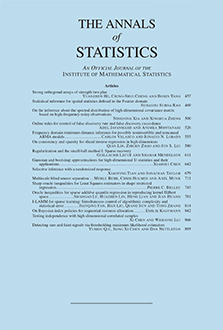Abstract
Consider estimating the mean of a standard Gaussian shift when that mean is known to lie in an orthosymmetric quadratically convex set in $l_2$. Such sets include ellipsoids, hyperrectangles and $l_p$-bodies with $p > 2$. The minimax risk among linear estimates is within 25% of the minimax risk among all estimates. The minimax risk among truncated series estimates is within a factor 4.44 of the minimax risk. This implies that the difficulty of estimation--a statistical quantity--is measured fairly precisely by the $n$-widths--a geometric quantity. If the set is not quadratically convex, as in the case of $l_p$-bodies with $p < 2$, things change appreciably. Minimax linear estimators may be out-performed arbitrarily by nonlinear estimates. The (ordinary, Kolmogorov) $n$-widths still determine the difficulty of linear estimation, but the difficulty of nonlinear estimation is tied to the (inner, Bernstein) $n$-widths, which can be far smaller. Essential use is made of a new heuristic: that the difficulty of the hardest rectangular subproblem is equal to the difficulty of the full problem.
Citation
David L. Donoho. Richard C. Liu. Brenda MacGibbon. "Minimax Risk Over Hyperrectangles, and Implications." Ann. Statist. 18 (3) 1416 - 1437, September, 1990. https://doi.org/10.1214/aos/1176347758
Information





